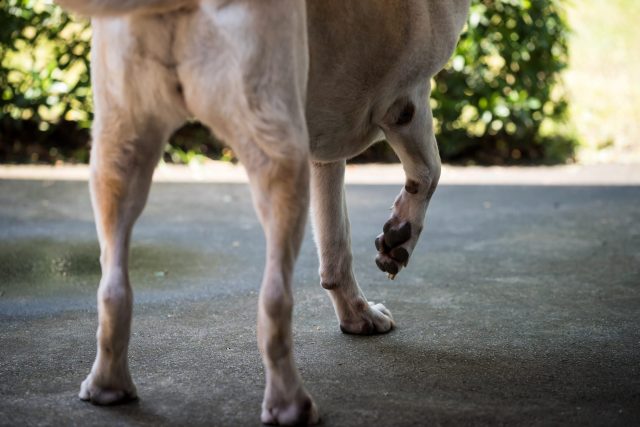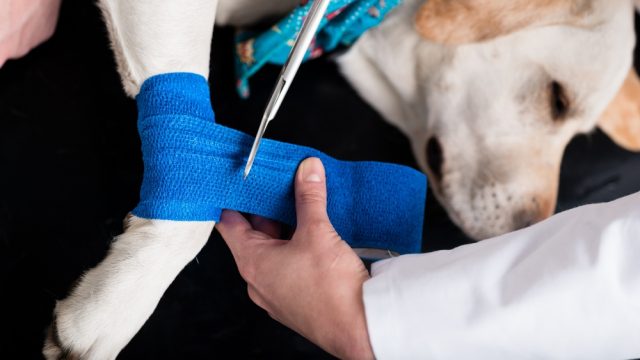Do you know what to do if your dog becomes seriously ill or injured?
Hopefully you will never face such a situation, but let’s take a look at how you should prepare for an emergency in case one ever arises.
Know Your Resources
Familiarize yourself with your veterinarian’s hours of operations. Ask your vet where the nearest emergency pet clinic is, and find out their hours. Get the contact information for both your pet and the emergency clinic and keep it in your cell phone as well as posted nearby your house phone. The ASPCA Animal Poison Control Center’s 24-hour hotline is available at (888) 426-4435; hotline operators can assist you if your pet ingests a toxic substance.
Know What Constitutes An Emergency
Be sure that you’re familiar with the signs of an emergency. Signs of shock in your pet include fast or strained breathing, pale gum color and “tacky” gums, and a rapid or unusually weak pulse. Other conditions, such as if your pet has difficulty controlling his body, seems very confused, is unconscious, or suffers an injury which causes him to bleed heavily, all warrant a trip to the emergency clinic.
What You Can Do
- Stay calm to avoid escalating your dog’s stress levels.
- Evaluate the situation to determine the severity of the emergency.
- Ensure your own safety before approaching the dog.
- Contact your veterinarian or the nearest emergency veterinary clinic for guidance and to let them know you’re on your way.
- If your dog is unconscious or having difficulty breathing, perform basic first aid such as CPR if trained.
- If there’s bleeding, apply pressure to the wound with a clean cloth to stop the bleeding.
- Keep your dog warm and comfortable, but avoid overheating.
Cuts/Wounds:
If your pet is cut and bleeding heavily, apply pressure to the wound and elevate if it possible to slow the bleeding. Be careful when touching your injured pet, as pain may cause normally affectionate pets to be aggressive. Try to place your pet onto a “stretcher” made of a towel or sheet if you need to move him.
Choking:
If your pet chokes, you can carefully attempt to remove the object by holding his mouth open and sweeping your fingers inside. If this is unsuccessful, then try a gentle Heimlich maneuver in the same fashion that you would attempt on a human. Remember to use less force, though, as your pet is smaller than a human.
Seizures:
If your pet is having a seizure, do not try to hold his body still. Encircle him with a towel and attempt to keep him from hitting his head, but to not use force or attempt to restrain his muscles. Realize that your pet has no control over his body, and keep yourself safe during this time. When the seizure is over, your pet may be disoriented; use caution when handling him or getting him into the car.
Do not administer any medications to your pet unless you’ve been previously instructed to do so in an emergency by your vet – instead, focus on getting him help. Medications can mask symptoms which may be vital for your vets to be aware of.
Get Help
As soon as possible, get your pet to a clinic where he can receive medical attention. Call ahead to give the staff a heads-up that you’re on the way – the call will allow them to prepare for your arrival. Once you get to the veterinary hospital:
- Provide as much information as possible about what happened and your dog’s symptoms.
- Follow any instructions given by the veterinarian carefully.
- Be prepared to make decisions about your dog’s care, including potential treatments and costs.
Be Prepared
- Keep a pet first aid kit at home and in your car with essentials such as gauze, adhesive tape, antiseptic wipes, and a muzzle.
- Regularly inspect your dog for any signs of illness or injury.
- Keep emergency contact numbers, including your veterinarian and the nearest emergency veterinary clinic, easily accessible.
- By being prepared and acting quickly, you can give your dog the best chance of recovery during a medical emergency.
Hopefully, you’ll never be in an emergency situation, but preparing yourself just in case will make the situation easier if it ever should occur.



